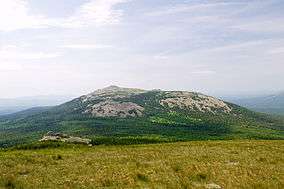Nurgush Nature Reserve
| Nurgush Nature Reserve | |
|---|---|
| Russian: Нургуш заповедник | |
|
IUCN category Ia (strict nature reserve) | |
|
Middle NUrgush Mountain, Nurgush Ridge | |
 Location of Reserve | |
| Location | Kirov Oblast |
| Nearest city | Kirov |
| Coordinates | 58°0′43″N 48°27′24″E / 58.01194°N 48.45667°ECoordinates: 58°0′43″N 48°27′24″E / 58.01194°N 48.45667°E |
| Area | 5,918 hectares (14,620 acres) |
| Established | 1994 |
| Governing body | Ministry of Natural Resources and Environment (Russia) |
| Website | http://nurgush.org/ |
Nurgush Nature Reserve (Russian: Нургуш заповедник) is a Russian 'zapovednik' (strict ecological reserve) One of the few intact forest landscapes of Northern European Russia, virtually untouched by human activities. It is designed to protect the floodplain complexes of the Vyatka River, numerous lakes and coniferous-deciduous forests. The reserved is situated in the Kotelnichsky District of Kirov Oblast. The reserve was created in 1994, but has been a protected area since at least 1952 when it was organized as a beaver reserve; it covers an area of 5,918 ha (22.85 sq mi).[1][2]
Topography
The terrain of Nurgush is typical floodplain, occupying a broad meandering section of the Vyatka River. The highest elevation is 93 meters above sea level; the typical ground level above the Vyatka is 5–6 meters. Among the lowing rolling ridges are numerous ponds, vernal pools, oxbow lakes, and other forms of wetlands, and in the river sandbars, shoals, and small sandy islands. The area floods almost completely every spring for a few days.[1] In non-flood times, about 20% of the territory is wetland. These areas are mostly forb-grass or sedge-grass. The reserve is located entirely on the floodplain, so it does not pick cover then entire local ecosystem; the surrounding elevated terraces are mostly forested in pine or spruce, but with widespread patches of alder and birch in disturbed areas.[3]
Climate and Ecoregion
Nurgush is located in the Scandinavian and Russian taiga eco-region. It is situated in Northern Europe between tundra in the north and temperate mixed forests in the south. It is covers parts of Norway, Sweden, Finland and the northern part of European Russia, being the largest eco-region in Europe. Coniferous forests dominated by Pinus sylvestris (in drier locations), often with an understory of Juniperus communis, Picea abies and Picea obovata and a significant admixture of Betula pubescens and Betula pendula. Larix sibirica is characteristic of the eastern part of the eco-region.
The climate of Nurgush is Humid continental climate, cool summer (Köppen climate classification (Dfb)). This climate is characterized by large swings in temperature, both diurnially and seasonally, with mild summers and cold, snowy winters.[4] Average annual temperature in January is -13.9 C, and +18 C in July. Average annual precipitation on the reserve is 583 mm.[2]
Flora and Fauna
Forests cover 72% of the territory. The most common birch, aspen, alder forests and willow thickets. A quarter of the territory is covered with conifers. Scientists of the reserve and its buffer zone have observed 30 species of fish, 8 species of amphibians, 6 species of reptiles, 197 bird species (141 nesting, 38 migrating, 9 stray, 9 wandering), and 47 species of mammals.[1]
The area has been protected from commercial activity at least since 1952, when the site was organized as a beaver reserve.
Ecotourism
As a strict nature reserve, the Reserve is mostly closed to the general public, although scientists and those with 'environmental education' purposes can make arrangements with park management for visits. There are several 'ecotourist' routes in the reserve, however, that are open to the public, but require permits to be obtained in advance. The main office is in the city of Kirov.[1]
See also
- List of Russian Nature Reserves (class 1a 'zapovedniks')
- National parks of Russia
- Protected areas of Russia
References
- 1 2 3 4 "Nurgush Zapovednik (Official Site)" (in Russian). Ministry of Natural Resources and Environment (Russia). Retrieved January 21, 2016.
- 1 2 "Nurgush Zapovednik" (in Russian). Ministry of Natural Resources and Environment (Russia). Retrieved January 21, 2016.
- ↑ "Nurgush Reserve". Floranimal Russia. Floranimal. Retrieved 17 April 2016.
- ↑ "Climate of Nurgush". GloalSpecies.org. Retrieved January 21, 2016.
